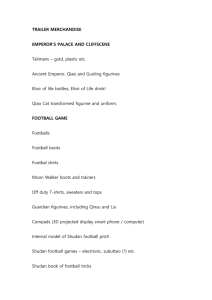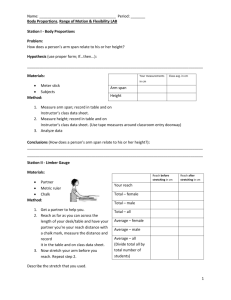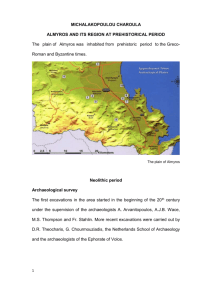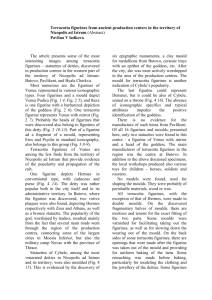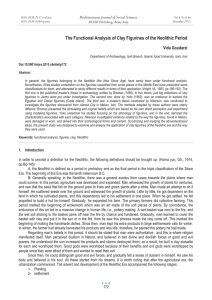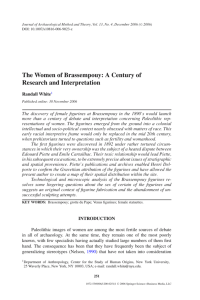neolithic figurines from thespiai - The American School of Classical
advertisement
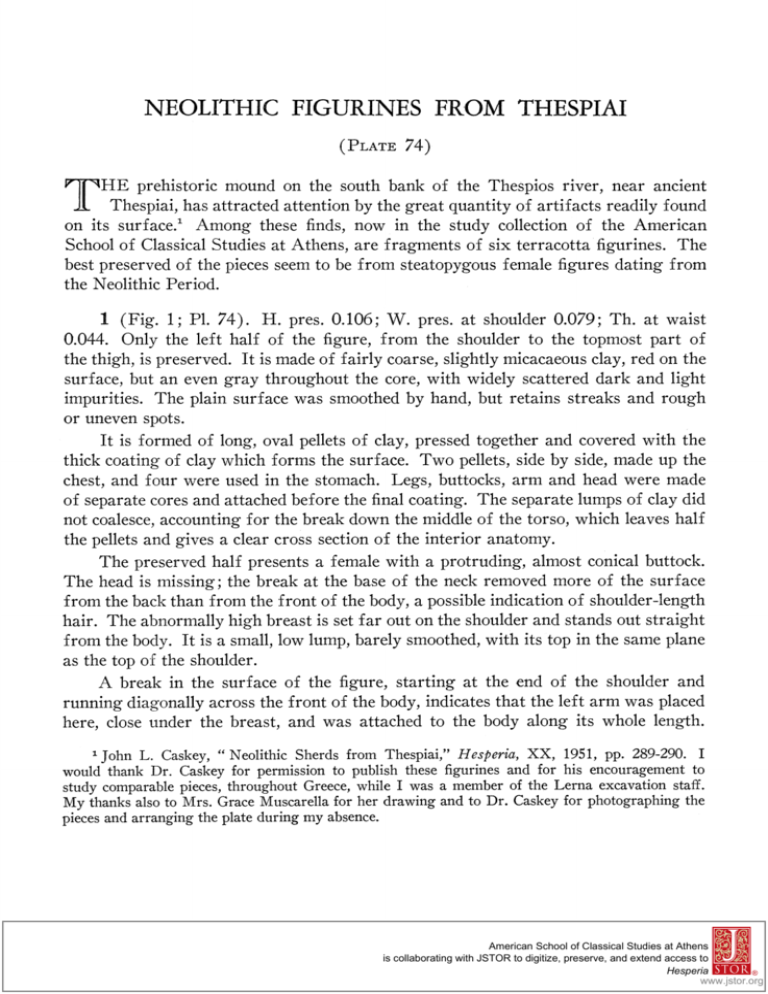
NEOLITHIC FIGURINES FROM THESPIAI (PLATE 74) HE prehistoric mound on the south bank of the Thespios river, near ancient Thespiai, has attracted attention by the great quantity of artifacts readily found on its surface.1 Among these finds, now in the study collection of the American School of Classical Studies at Athens, are fragments of six terracotta figurines. The best preserved of the pieces seem to be from steatopygous female figures dating from the Neolithic Period. T 1 (Fig. 1; P1. 74). H. pres. 0.106; W. pres. at shoulder 0.079; Th. at waist 0.044. Only the left half of the figure, from the shoulder to the topmost part of the thigh, is preserved. It is made of fairly coarse, slightly micacaeous clay, red on the surface, but an even gray throughout the core, with widely scattered dark and light impurities. The plain surface was smoothed by hand, but retains streaks and rough or uneven spots. It is formed of long, oval pellets of clay, pressed together and covered with the thick coating of clay which forms the surface. Two pellets, side by side, made up the chest, and four were used in the stomach. Legs, buttocks, arm and head were made of separate cores and attached before the final coating. The separate lumps of clay did not coalesce, accounting for the break down the middle of the torso, which leaves half the pellets and gives a clear cross section of the interior anatomy. The preserved half presents a female with a protruding, almost conical buttock. The head is missing; the break at the base of the neck removed more of the surface from the back than from the front of the body, a possible indication of shoulder-length hair. The abnormallyhigh breast is set far out on the shoulder and stands out straight from the body. It is a small, low lump, barely smoothed, with its top in the same plane as the top of the shoulder. A break in the surface of the figure, starting at the end of the shoulder and running diagonally across the front of the body, indicates that the left arm was placed here, close under the breast, and was attached to the body along its whole length. 'John L. Caskey, "Neolithic Sherds from Thespiai," Hesperia, XX, 1951, pp. 289-290. I would thank Dr. Caskey for permission to publish these figurines and for his encouragement to study comparable pieces, throughout Greece, while I was a member of the Lerna excavation staff. My thanks also to Mrs. Grace Muscarella for her drawing and to Dr. Caskey for photographing the pieces and arranging the plate during my absence. American School of Classical Studies at Athens is collaborating with JSTOR to digitize, preserve, and extend access to Hesperia ® www.jstor.org NEOLITHICFIGURINESFROM THESPIAI 345 The scar in the surface widens at its lower end, near the center of the body, suggesting that there may have been a hand at this place. The back is quite vertical, becoming slightly concave at the small of the back, then swelling out to form the left buttock. A deep groove represents the hollow which follows the spinal column, and it is along this central line that the figurine has split in two. Only the topmost part of the back of the thigh is preserved, sharply set off from the buttock. FIG. 1. No. 1, CrossSection. The front of the figure swells evenly from a rather narrow chest to a heavy, slightly sagging abdomen. The deep navel was punched by a pointed implement at an upward angle. A very slight groove marks the lower edge of the belly. The flat groin is divided from the thigh by an incised line which curves up and around the hip. The vulva is represented by a simple incised line. The closest parallel is a figurine from Magoula Balomenou, No. 566 in the Chaironeia Museum.2 It is of similar fabric, but with a more highly burnished plain 2 Georges Sotiriades, " Fouilles prehistoriques en Phocide," Rev. 1St. Gr., XXV, 1912, p. 257, fig. 4, top center; A. J. B. Wace and M. S. Thompson, Prehistoric Thessaly, p. 200, fig. 141, d. GEORGE F. BASS 346 red surface. Both arms are attached to the body, close under the breasts, and widen into crude hands near the center of the body. The large breasts are also widely set and at shoulder height. The lower abdomen and upper part of the leg are missing. Two other unpainted red figurines in the Chaironeia Museum, especially No. 580, in which these parts are preserved, are comparableto the one from Thespiai.3 2 (P1. 74). H. pres. 0.065; W. pres. at shoulders 0.087; W. at waist 0.049; Th. at thinnest part of waist 0.032. The biscuit is fairly fine, slightly micacaeous, with particles of white matter throughout. A thin, buff surface covers a gray core, which was made up of pellets as in No. 1. This surface was highly burnished and then decorated with orange-red paint, which has crackled. The head is missing, the break running down into the painted triangle on the back. Just enough is preserved, however, to indicate that either the neck or long hair started from the edges of this triangle, as several points along it begin to rise away from the body. The break is fairly deep, as if the neck had been set into a socket. The left breast, lower and larger than that of the first figurine, is preserved, rounded out from the shoulder. It is roughly conical, standing straight out from the body, and is smoothed into the surface of the chest. The right breast and a large surrounding area of the surface are missing; this break continues around the shoulder, onto the back; all traces of the right arm are gone. The left arm is also missing from the shoulder. The positions of the arms cannot be determined, but it is obvious that they did not support the breasts in the common position. A break in the surface of the left hip, however, may mark a place where the left hand or lower part of the arm was attached to the body. The surface on this side of the body is rough, perhaps because it was here concealed by the arm and could not be burnished. The right side of the body is smoothed, but the right side of the belly has an unburnished patch. Is it possible that the arm was somehow held in front of the body here? More likely, I believe, the arm was held out to the side or above the shoulder.4 The body is squatter than that of the first figurine, swelling rapidly from the thorax downward. The navel is a large hole punched downward with a squared, pointed implement. A groove runs along the base of the upper abdomen, separating it from a flatter band below. The hips widen from the waist. The back is flat across, 3 Christian Zervos, L'art en Grece (2nd ed.), plate 2, bottom left figure. This pose is not so common as others, but there are examples of it. A white-slipped figurine from Tsangli has a raised right arm, while the left hand rests on the waist (Wace and Thompson, Prehistoric Thessaly, fig. 75, b). Although this piece is from Layer V at Tsangli, W. and T. find it more similar to the figurines of Layer III, in which pottery of class A3,8 predominates. Another Thessalian figure, as yet unpublished, holds a similar pose but is dissimilar in most other respects. 4 NEOLITHIC FIGURINES FROM THESPIAI 347 with no central groove, but curved in its vertical plane. The smooth break under the body shows the sockets inltowhich the legs were fitted. The painted patterns on the figure seem to represent clothing, or at least straps. Two ladder-patternedstripes start from the back, probably just above the buttocks, and spread widely to pass over the shoulders; then they converge again across the breast and meet a horizontal stripe at the high waist. Only a few traces of this line are preserved on the fragment, but it seems to run completelyaround the front of the body, and in all probability completely encircled the figurine. It undoubtedly represented a belt or the top of a girdle held up by the straps. Also starting from a point on the back, a wide, vertical stripe splits into two sections which encircle the neck and terminate in front in a circular pendant which hangs level with and between the breasts. Whether or not this circle was filled in solidly with paint cannot be determined,since the surface at the center is chipped. 3 (P1. 74). H. pres. 0.058; W. 0.020; Th. 0.011. The leg, foot and part of the pelvic region are well preserved, but the right side of the foot is chipped. The clay is fairly fine, with very few impurities, but slightly micacaeous. It is light brownish buff throughout. The surface was highly burnished with vertical strokes, except on the inner surface of the leg, which is only casually smoothed and may have been lightly attached to the left leg. It was built around a cigar-shaped core. The decoration is in orange-red paint. A small portion of the groin is preserved. From here the leg descends, straight in front and back but swelling slightly on the outer side from the hip downward. The inner side of the leg, where it was against the left leg, is flat. At the bottom of the leg, the back and side are constricted just above the low, broad foot, where the front splays slightly to form the toes. The spaces between the toes are represented by four straight incisions. There are no indications of knees in front or back. The surface of the back of the leg shows where a large buttock, occupying more than a third of the height of the leg, was attached. The painted patterns may representclothing. Four vertical stripes, evenly spaced, run down the outer side of the leg. Near the bottom of these is a horizontal stripe which crosses the longest of the verticals. Below this a wide, horizontal band, reaching almost to the bottom of the foot, runs round the back and outer side. This piece is similar to the leg of No. 567 in the Chaironeia Museum.5 The leg of the Chaironeia figurine is far more curved, but both have the flat groin, the large buttocks, and the similar flat feet, with protruding heels and incised toes. The painted red patterns are not the same. 5 Sotiriades, loc. cit., bottom center. Also see Sotiriades, HpotaroptKa ayydZa Xatpwvedav xa' EAXret'as,'E+. 'ApX., 1908, pp. 63-96, plate a', no. 1. The best photograph of the figure is in Zervos, op. cit., plate 2, far right. 348 GEORGE F. BASS 4 (P1. 74). H. pres. 0.041; W. pres. 0.052; W. of chest 0.030; Th. of chest 0.020. Only the chest, shoulders and part of the left arm are preserved. It is made of fairly fine, slightly micacaeous clay with some white and a very few dark impurities. The biscuit is even light gray; the surface is pale red, well smoothed by hand. The head is missing, leaving a large, wide break in the surface above the straight shoulders. Another break in the surface, across the chest, seems to indicate the position of breasts applied at shoulder level. Rough places in the surface below this area may indicate that the missing right arm ran diagonally down across the body beneath the breasts, or that the forearm returned horizontally across the thorax. The left arm was not attached to the front of the body. Almost none of the lower trunk is preserved. The back is very flat and straight, with a deep, wide groove running down its center. 5 (P1. 74). H. pres. 0.047; L. from heel to toe 0.054; approx. W. 0.042. Almost all of the left foot, to above the ankle, is preserved. It is of fairly coarse, slightly micacaeous clay with tiny white and dark particles. It is pale reddish brown in color, with an even gray interior. The surface was burnished, except for the bottom which was left merely smooth. The almost cylindrical lower leg flares in front to make a foot in the form of an oval pedestal. In the top of this protrusion are three deep, evenly spaced, crudely incised lines, representing the spaces between the toes. The back of the foot is missing, and the shape of the leg is uncertain. The right side of the foot is rough, where the other foot has been broken away, but the left side is slightly concave. On top, in the break from the leg, is a smooth depression that could have been pressed with a thumb. This indicates either that the figure was hollow, with heavy feet to help it stand, or that this was a socket into which the leg fitted. 6 (P1. 74). H. pres. 0.059; W. pres. 0.046; Th. 0.008. Too little of this hollow fragment remains to allow a satisfactory restoration. We may only speculate that the short, deep incision represents the vulva of a female figure, with the adjacent parts of the belly, groin, and right thigh. The clay of which it was made is fairly fine, slightly micacaeous, containing some white and dark impurities. The pinkish buff outer surface has been burnished in accessible places; otherwise it has been smoothed with fingers. The gray inner surface is streaked and uneven. The V chevrons on the upper leg and just above it and the crude V at the base of the incision are both in lustrous red, crackling paint. The hollow form and presumably large size make this piece unique among these figurines. Steatopygous female figurines are found throughout a broad geographical and chronological range in the Mediterraneanarea. As would be expected, however, those closest in style to the first three of our Thespiai fragments are those from the Neo- NEOLITHIC FIGURINES FROM THESPIAI 349 lithic settlement at neighboring Chaironeia. Many other published pieces have been representedonly with poor photographs,which may be misleading. Actual comparison of the objects, however, has shown that nowhere else, not even in other Boeotian sites, are the similarities so strong.6 The dating of the figurines is difficult. The fabrics of the first three figurines, as well as that of the sixth, are typical of Wace and Thompson's First Period. Since Chaironeia, which supplies the closest parallels, was deserted at the end of the First Period,7 we have two strong indications of an early dating. Caskey's recent excavation at Eutresis, however, has revealed two plain figurines of the same style, which seem to belong to a later period. The pottery associated with these contains no examples of red-on-white Chaironeia ware or any other exclusively early Neolithic wares. Therefore, we may only conclude that we have from Thespiai a group of steatopygous female figurines dating from the Neolithic Period and showing strong contacts between that settlement, Chaironeia and, possibly, Eutresis. A more precise date must await further research at these sites. GEORGEF. BASS U. S. ARMY, 6 See, KOREA however, two figurines found by John L. Caskey in a supplementary excavation at Eutresis in September 1958 (to be published in Hesperia shortly). Dr. Caskey kindly supplied me with information and photographs of these figurines, but I have not yet seen the original pieces. Somewhat farther afield, but of equal interest, are the figurines found by James Melaart in his excavations at Hacilar in Turkey. These not only display similar shapes, but are also in plain, burnished wares and wares with red paint on a light ground (James Melaart, " Excavations at Hacilar," Anatolian Studies, VIII, 1958, pp. 144-148, fig. 9, no. 2; fig. 10, nos. 1 and 5; pl. XXXII, a and b, showing photographs of the same objects). 7 Wace and Thompson, op. cit., p. 244. See also note 4 on the dating of the Tsangli figurine. PLATE 74 No. 1. Front, Side and Back _' ' i_ ~~~~~~~~~~~~~1IU No. 2. Front, Side and Back No. 4. Front and Back No. 3. Side and Front
